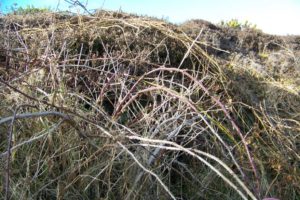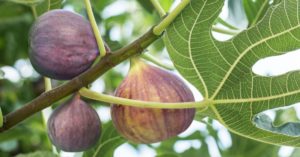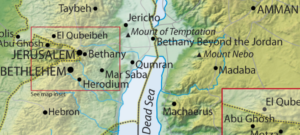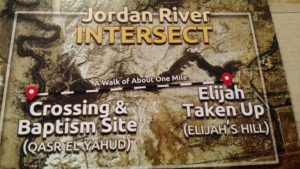
Whenever we think of parables in the Bible, we often only think of the parables spoken by Jesus and recorded in the New Testament. However, to the surprise of some, there are also several parables in the Old Testament including Jotham’s parable in Judges 9 that sheds considerable light on past and future events in both testaments.
His name means “my father is king.” And his father certainly lived like a king, but he refused to establish any form of dynasty in Israel for himself or his sons. It is obvious that Abimelech thought his warrior hero father had made a mistake. He was the son of Gideon by a concubine who lived with her father’s family in Shechem, and he undoubtedly was shunned by his half-brothers. His father was an Israelite, but his mother was a Shechemite.
The story of Gideon’s success as a great warrior is riveting and a great testimony unto the Lord. However, his epitaph is shadowed with disappointment. He had missed a great opportunity to bring reform and revival to the land of Israel. Instead of using the moment of his heroism to bring glory to God, he chose instead to profit himself. It is thus recorded, “And it came to pass, as soon as Gideon was dead, that the children of Israel turned again, and went a whoring after Baalim, and made Baal-Berith their god.” (Judges 8:33)
Our story now unfolds. It is interesting that in Judges 9-10, Gideon is always called Jerubbaal, never Gideon.
“And Abimelech the son of Jerubbaal went to Shechem unto his mother’s brethren, and communed with them, and with all the family of the house of his mother’s father, saying, Speak, I pray you, in the ears of all the men of Shechem, Whether is better for you, either that all the sons of Jerubbaal, which are threescore and ten persons, reign over you, or that one reign over you? remember also that I am your bone and your flesh.” (Judges 9:1-2)
His mother’s brothers pledged allegiance to Abimelech, and they gave him 70 pieces of silver from the house of Baal-Berith to finance a crusade against his 70 half-brothers. In this act he made the public announcement that he had renounced the God of Israel for Baal. With hired men he went to the house of Ophrah and slew all of Gideon’s sons except the youngest Jotham who hid himself in the slaughter. (verses 3-5)
“And all the men of Shechem gathered together, and all the house of Millo, and went, and made Abimelech king, by the plain of the pillar that was in Shechem.” (verse 6)
It is here that in his godlessness and selfish acts Abimelech defiled a place sacred in Jewish history.
Beth Millo translates “house of the fortress” and is the section of the upper classes. The word “plain” is ‘elown’ or a “great tree or oak” and is undoubtedly the well-known sacred tree of Moreh (Genesis 12:6; 24:1-5; 35:4; Deut. 11:26-32; Josh 8:30-35; 24:25-26)
“And when they told it to Jotham, he went and stood in the top of mount Gerizim, and lifted up his voice, and cried, and said unto them, Hearken unto me, ye men of Shechem, that God may hearken unto you.” (verse 7)
Mount Gerizim was a place for blessings to be read (Deut. 27:12, 28), but Jotham’s speech was anything but a blessing. He continues:
The Parable of the Trees
“The trees went forth on a time to anoint a king over them; and they said unto the olive tree, Reign thou over us. But the olive tree said unto them, Should I leave my fatness, wherewith by me they honour God and man, and go to be promoted over the trees?
And the trees said to the fig tree, Come thou, and reign over us. But the fig tree said unto them, Should I forsake my sweetness, and my good fruit, and go to be promoted over the trees?
Then said the trees unto the vine, Come thou, and reign over us. And the vine said unto them, Should I leave my wine, which cheereth God and man, and go to be promoted over the trees?
(In each case, the trees refused the honor. Each would have to sacrifice something in order to reign and they weren’t prepared to make that sacrifice.)
Then said all the trees unto the bramble, Come thou, and reign over us. And the bramble said unto the trees, If in truth ye anoint me king over you, then come and put your trust in my shadow: and if not, let fire come out of the bramble, and devour the cedars of Lebanon.” (verses 8-14)
(A bramble, or thornbush, was a useless nuisance, the most worthless plant in the Middle East. It produces no fruit, and is too low to the ground to produce any shade. Its wood cannot be used for any kind of construction because it splits too easily. It is good only as fuel for the fire. And this was, of course, the symbol of Abimelech.)
It is known as the principle of “expositional constancy” whereby the Holy Spirit tends to use the same symbols consistently throughout Scripture. As an example, remember that both Ezekiel 31 and Daniel 4 use trees to symbolize leaders or nations. Last week’s blog cited the “parable of the fig tree.” The Bible clearly uses all four of the trees to reference Israel. How so?
| The Parable of the Trees | |
| Olive Tree | represents the Lineage or Genealogy of Israel |
| -produces valuable oil | |
| Fig Tree | represents Political Israel |
| -produces sweet fruit | |
| Vine | represents Spiritual Israel |
| -produces wine | |
| Bramble | represents Satan’s empire/kingdom of darkness |
| -no fruit | |
| -only good as fuel for the fire | |
Jotham had clearly made his point. If you read chapters 9-10 Abimelech, the “bramble king” would be unable to protect the people and would cause judgment to come that would destroy those who trust in him. After three conditional clauses, this was a prophecy and a curse. In its fulfillment, both Abimelech and his followers would destroy one another (literally in verse 57) and leading to his ignominious death.
Jotham’s parable looks all the way back to Genesis where we are first introduced to thorns being a symbol of the “curse.” In speaking to Adam after the Fall, God says, “Cursed is the ground because of you; through painful toil you will eat food from it all the days of your life. It will produce thorns and thistles for you, and you will eat the plants of the field.” (Genesis 3:17b-18)
Thorns are a symbol of the “curse” and impending judgement. Throughout the Middle East it is the Acacia bush which is known as “the thorn bush of the desert.” And it is highly likely that this was the type of bush or bramble that Moses encountered at Mount Horeb.
“And the angel of the Lord appeared unto him in a flame of fire out of the midst of a bush: and he looked, and, behold, the bush burned with fire, and the bush was not consumed.” (Exodus 3:2)
It was a burning bush that is not consumed. It is a symbol of grace. Why?
Acacia= “thorn bush of the desert”
Thorns= symbol of the curse
Fire= symbol of judgement
Even the writer of Hebrews reveals that thorns were viewed negatively in the ancient cultured and considered a curse. “For land that has drunk the rain that often falls on it, and produces a crop useful to those for whose sake it is cultivated, receives a blessing from God. But if it bears thorns and thistles, it is worthless and near to being cursed, and its end is to be burned.” (Hebrews 6:7-8)
After being mocked, beaten and spat upon by the Roman soldiers, Jesus was crowned with thorns and this highlighted that His suffering and death were a curse. “Christ redeemed us from the curse of the law by becoming a curse for us—for it is written, ‘Cursed is everyone who is hanged on a tree.” (Hebrews 3:13) When our Lord was crowned with a crown of thorns, His torturers unknowingly punished Him with a symbol fitting of the suffering Messiah.
Fortunately for us, Jesus rose from the dead and is gloriously revealed as the King and Savior of this world. Thus, for all who believe, we are not bramble dedicated for destruction. In fact, as Christians we are branches “grafted in” to the Olive Tree and bearing fruit for our Lord. (Romans 11:17-24; Ephesians 2:11-13; 2:19; 3:6)
Carpenter Ministries, Inc. is fully dependent upon the support of others for the continuation of this ministry. If “A Carpenter’s View” blesses you in any way or adds value to you I would ask you to prayerfully consider supporting us with your financial gifts. Donations can be made in three ways, please go to “contributions” on the blog site to find.



